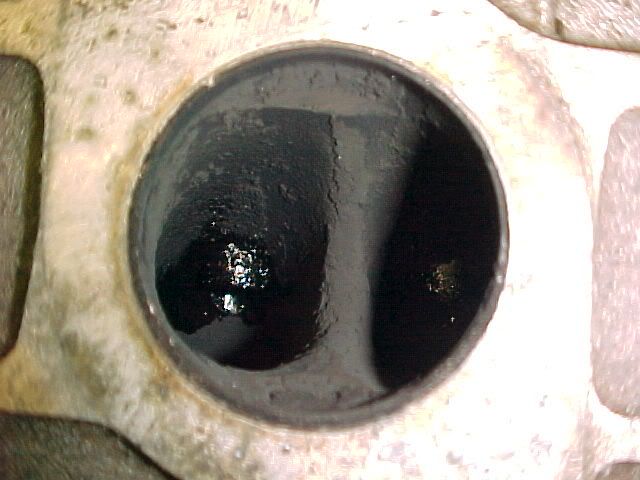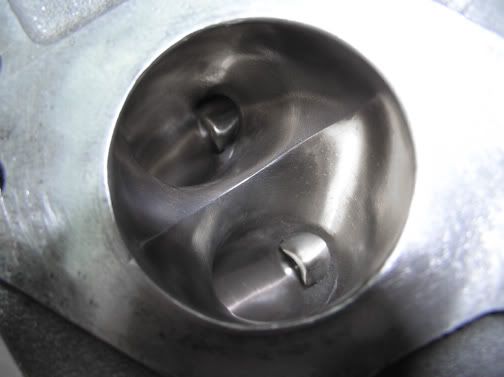Does anyone know good books on head porting? I have heard of people doing Dremel jobs on heads. How bad an idea is this?
On an aluminum head, a Dremel with good bits will do a fine job. I've ported heads with them. The best and worse part of using a Dremel is you're using generally pretty small diameter cutters. Makes doing large areas a bit challenging to get or keep smooth.
Iron is much slower. Still doable, but slower.
I have not ever tried using one of the whip attachments with a Dremel.
As Wonkothesane mentions, have a plan of attack, and a basis for that plan of attack. Just removing metal generally will not get you a positive gain. You've got to remove the right metal.
I ported the head on the Mini. Cast iron is a bitch, even with carbide bits, using a Dremel with flex shaft. I used a "pattern" from a book specifically about the A-series motor. Basically, all I did was knock the valve guide bosses down a bit and reshaped them and opened the ports a little. and old manifold gasket will help show how far you can go, although bigger isn't always better. Shape is better than outright size.
Wear a mask! Set up a vacuum hose on the opposite end of the port you're working on.
I was told for a little power, leave the intake alone, and just gasket match and smooth the exhaust. Works great on older engines (80's stuff, American V8's.) Not huge power, but safe also.
wheelsmithy wrote: I was told for a little power, leave the intake alone, and just gasket match and smooth the exhaust. Works great on older engines (80's stuff, American V8's.) Not huge power, but safe also.
That's generally a bad idea, although the opposite is generally true. Having an ridge on the exhaust side going into the manifold helps exhaust scavenging. It you want gains but don't want to screw up anything, gasket match the intake side, take out all the casting marks, take out any ridges in the short side radius, and leave the intake side slightly rough (100 grit or so), and polish the exhaust side.
Before:

After:

I've been wondering this myself, and I picked up an ABA head from the boneyard to practice on. It seems if you go beyond what Corey said without a template, the possibility of messing something up is very high.
Rotary engines are so very much easier to port.
93EXCivic wrote: Does anyone know good books on head porting? I have heard of people doing Dremel jobs on heads. How bad an idea is this?
one of the reasons I've liked alfas- people like to publish the results. There's a good book on a 2.0l WRT porting.
And I did my old head with a dremel. the only note I would suggest- make sure the took is for aluminum- galling it up really sucks. My fingers hurt after i was done.
But it worked really well.
Be careful.... You can easily screw things up too....
Also, experience with the head you are working on is VERY useful.
A few old hotrodder tricks don't always hold true in the modern age. One that is often now debated is smooth intakes, or leaving them with a slightly rough surface. In olden days fuel was mixed with the air in the carb... the rough texture helped keep the fuel and air atomized. With modern port injection(and even more so with direct injection) the arguement of intake port smoothness is less obvious.
Things that always help...

smoothing the valve seat into the surrounding bowl.

3 angle

with back cut valves (middle valve is back cut)
Anything else is tough to quantify without a flowbench.
Too big is far worse then too small.
Here are a few shots of my work with Toyota "A" heads


my portfolio of recent jobs - http://s79.photobucket.com/albums/j143/oldeskewltoy/MOmo/#!cpZZ1QQtppZZ16
Concerning home building a flowbench... I used Flow Performance bits, and I assembled my own


The only right way to do porting is with lots of fluid-flow research and testing of finished heads on a proper flow-bench. So many times pictures are posted of shiny ports, which means absolutely nothing without a before and after printout of the flow-bench results.
The only way around doing it right is to obtain a proven identical head, taking many measurements, and replicating it. Anything past simple cleanup leans dangerously close to religion, where as long as the person thinks it's better, it therefore must be.
You'll need to log in to post.